Corrective procedures for high and low substrate pH and electrical conductivity
Be prepared this spring with corrective procedures for the battle against high or low substrate pH or electrical conductivity (EC).

In 2017, many greenhouse growers endured the battle against low substrate pH. For spring 2018, time will only tell what production challenges awaits. In an effort to prepare for potential nutritional disorders induced by low or high substrate pH or soluble salts, referred to as electrical conductivity (EC), corrective procedures adopted from e-GRO Alert 7.2 are indicated below and available as an 11-inch by 17-inch printable poster.

An 11-inch by 17-inch printable poster outlining the corrective procedures for low or high substrate pH and electrical conductivity (EC). View larger, downloadable poster.
Low substrate pH correction (options)
Flowable limestone
- Apply 1 to 2 quarts per 100 gallons of water.
- Rinse foliage after application.
- Avoid damage to your injector by using rates of 2 quarts per 100 gallons of water or less.
- Split applications if needed.
Hydrated lime
- Mix 1 pound in 3 to 5 gallons of WARM water.
- Mix twice.
- Let settle.
- Decant liquid and apply through injector at 1:15.
- Caustic (rinse foliage ASAP and avoid skin contact).
Potassium bicarbonate (KHCO3)
- Use 2 pounds per 100 gallons of water.
- Immediately rinse foliage.
- Provides 933 ppm K.
- The following day, leach heavily with a complete fertilizer to reduce substrate EC and restore nutrient balance.
- Rates greater than 2 pounds per 100 gallons of water can cause phytotoxicity!
High substrate pH correction (options)
Acid-based fertilizer
If substrate pH is just beginning to increase:
- First consider switching to an acidic-based fertilizer.
- Ammoniacal-nitrogen (N) based fertilizers are naturally acidic and plant nitrogen uptake will help moderate the substrate pH over a week or two.
Acid water drench
If substrate pH levels are not excessively high and a quick lower is desired:
- Use sulfuric acid to acidify your irrigation water to a pH 4.0 to 4.5.
- Apply acid water as a substrate drench providing 5 to 10 percent excessive leaching of the substrate.
- Rinse foliage to avoid phytotoxicity.
- Results should be visible within five days.
- Retest substrate pH.
- Repeat if needed.
Iron drenches (three options)
- Apply as a substrate drench with sufficient volume to leach the pot.
- Rinse foliage immediately.
- Avoid use on iron efficient plants (geraniums).
- Iron-EDDHA: Mix 5 ounces in 100 gallons of water.
- Iron-DTPA: Mix 5 ounces in 100 gallons of water.
- Iron sulfate: Mix 4–8 ounces in 100 gallons of water.
Low substrate EC correction
If low EC problems occur, increase the fertilization rate to 300 ppm N for a few applications before returning to the recommend fertilization rate for the crop.
High substrate EC correction (options)
Switch to clear water irrigations
If EC is just beginning to increase over time:
- Apply a few clear water irrigations to lower EC levels by allowing the plant to utilize the fertilizer salts.
Clear water leaching
If EC values are excessively high:
- Leach substrate twice with back-to-back clear water irrigations.
- Allow substrate to dry down normally.
- Retest the EC.
- If EC levels are still too high, repeat the double leach.
- Once the substrate EC is back within the normal range, use a balanced fertilizer at a rate of 150 to 200 ppm N.
For more information, read “Corrective Procedures for Modifying Substrate pH and Electrical Conductivity (EC)” in e-GRO Alert 7-02:1–5.



 Print
Print Email
Email


